The year 2003 marked the fiftieth anniversary of the execution of Julius and Ethel Rosenberg. Their killing had a great impact on my wife Andrea Carney (see Part 1 and Part 2 of our trilogy). Somehow I learned that a major commemoration would be held in New York City on June 19, the same day they were killed. It was produced by the Rosenberg Fund for Children, founded in 1990 by the Rosenbergs’ son Robert, who was grateful for the support he and his brother Michael had been shown during the jailing of, and after the killing of, their parents. The fund’s purpose is “to find and help children today who are enduring the same kind of nightmare he endured as a child.”1
I told Andrea we’d be going to New York “to see a concert” without saying more. The surprise was spoiled when my father blurted out “the Rosenbergs” on a telephone call when she’d mentioned she didn’t know the purpose for our trip. Immediately she went online and found the particulars.
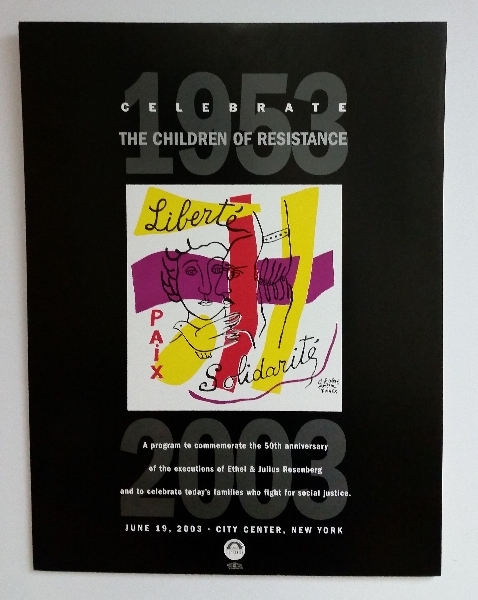
Nevertheless I made all the other plans without telling Andrea. And this week I found a file folder labeled NY – 2003. So what follows is a sort of How I Spent My Summer Vacation from sixteen years ago. It was a short trip—three days and two nights—but as usual I’ll go into quite a bit of detail dependent on what I remember.
Le Bernardin
We took a red-eye from Long Beach to JFK, arriving early Thursday, the day of the event. We stayed where we had before with my parents, at the Roosevelt, on 45th between Madison and Park Avenues (less grand than it sounds). We’d paid for that “night” and slept the day away but somehow had the energy to buy me a coat because dinner had a dress code. During our walk we noticed a gallery we’d return to.
Dinner before the Rosenberg event was extravagant, at Le Bernardin, which I must have chosen for its vegetarian options. (It was Le Bernardin’s chef Eric Ripert who found his friend Anthony Bourdain’s body last year during one of their many culinary escapades.) My file contains notes from both our evening meals. We shared a mixed salad of bitter greens, teardrop tomatoes, mint, and blanched vegetables. Andrea had tuna tartare, a crab something or other, salmon with mushroom-truffle sauce, and an apricot sorbet gratinée for dessert. (We’re both surprised at her appetite!) I had a baby Asian vegetable salad, a tomato tart with Japanese sprouts, two-mushroom ravioli, and a lemon-ginger creamy mousse with caramel filigree. Wine: a 2000 Tardieu-Laurent Hermitage red.
The Program
The Rosenberg commemoration, held at City Center, was called Celebrate the Children of Resistance and it had been performed before in 1997 and 2000 with variations. As the Fund for Children states in a report we picked up, the Rosenberg sons’ “childhood became a living nightmare.”
Their relatives were so frightened of being associated with “Communist spies” that they refused to take the boys into their homes. First they lived in a shelter. Later they lived with friends of their parents in New Jersey, but were thrown out of that state’s public school system after the local school board found out who they were. After their parents’ execution, the New York police seized the boys from the home of Abel and Anne Meeropol, their future adoptive parents. That time they were placed in an orphanage.
Bad as this was, it could have been even worse. As Robert grew older, he came to realize the debt he owed to so many generous individuals whom he had never met, but who rallied to his support—helping wage the legal battles to reunite him and his brother with the Meeropols, raising a trust fund that enabled them to attend schools and summer camps where progressive values were appreciated.2
Like the 1975 event Andrea wrote about last time, this presentation featured many celebrity supporters, including Susan Sarandon as MC. It was divided into three parts: The Past, The Present, and The Future.
The Past
Ethel and Julius’s prison letters were read by Tovah Feldshuh and Peter Yarrow. A dramatization called Union Square, June 19, 1953 was performed by Harry Belafonte, Suheir Hammad, and Emillie Miller. The Meeropol brothers spoke of their memories. Holly Near and Ronnie Gilbert provided music along with accompanist John Bucchino. Poet Martín Espada read The Eleventh Reason, based on Robert Meeropol’s remembrance, at age six, of “eleventh hour” appeals.
The Present
Harry Belafonte read a message of support from Mumia Abu-Jamal, who we might tend to forget is the father of eight children. Janiece Thompson sang “Strange Fruit,” written by the Rosenberg sons’ adoptive father Abel Meeropol. Bill T. Jones performed an untitled dance solo (about which much more below).
The Future
The final section of the program led off with more music from Janiece Thompson and another poem by Martín Espada.
Stories from the Rosenberg Fund for Children were read by Holly Near, Bill T. Jones, Peter Yarrow, Tovah Feldshuh, Janiece Thompson, Ronnie Gilbert, Emilie Miller, Suheir Hammad, and two RFC beneficiaries, Mazi Ibn Jamal and Suemyra Shah. Jenn Meeropol—the Rosenbergs’ granddaughter (and now RFC executive director)—spoke about The Next Generation. The finale featured Pete Seeger and the Camp Kinderland Chorus.
The event’s printed program emphasizes the sustained support the RFC had given over the previous dozen years to the families of: labor and environmental icon Judi Bari who was nearly killed in 1990, an African American political prisoner named Ida, a Navajo environmental activist, a Cameroonian pro-democracy activist, and a Native Hawai‘ian blacklisted anti-racist, as well as The Marjorie Kovler Center for the Treatment of Survivors of Torture and members of the Puerto Rican nationalist community. (Only Judi Bari’s full name appears.)
Included in the program are lyrics to “Dear Mister Eisenhower,” a talking blues by Woody Guthrie, which Pete Seeger had performed three years before at the RFC’s tenth anniversary event.
Reexamining the printed program this week Andrea and I found we’d missed an ad for an exhibition titled We Remember: Art and the Rosenbergs held at The Puffin Room while we were there. Unwittingly, in 2013 on the sixtieth anniversary of the executions, I gave Andrea a monograph that had been paired with that same exhibition, titled The Rosenbergs: Collected Visions of Artists and Writers, edited by Rob A. Okun.3 In 1990 Okun had co-directed the documentary Unknown Secrets: Art and the Rosenberg Era—also the title of a companion traveling exhibition. A clip from Unknown Secrets:
Taking (in) Pictures
Following the Thursday event, on Friday and Saturday, June 20 and 21, we went gallery hopping, most of it photography. I guess we must have gone to Soho because we had a snack in Little Italy at Ferrara, which claims to be this country’s first pasteria and espresso bar.
Along the way we visited the galleries of the International Center of Photography (then) at 6th Avenue and 43rd, which we’d passed on our walk the day before. We’d made note of the main exhibition’s title, Cuba on the Verge: An Island in Transition, which the images reflect.
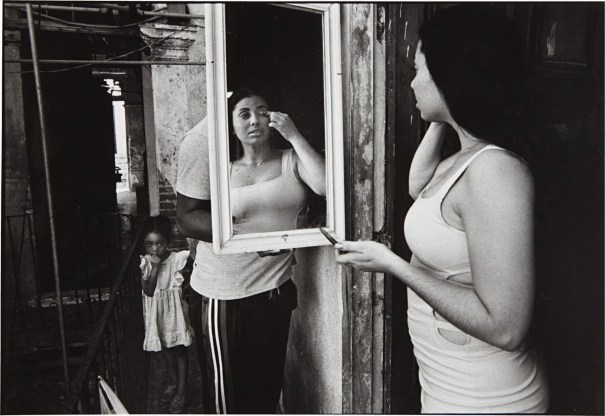
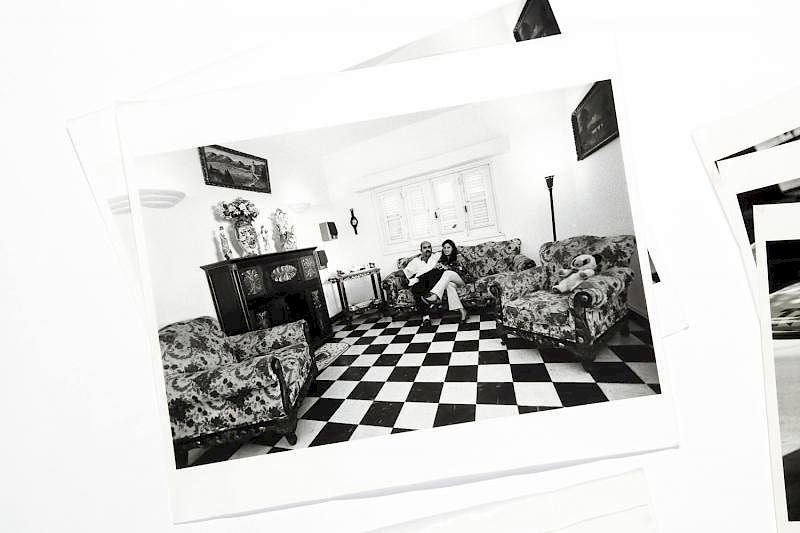
What we hadn’t expected at the ICP was Dreaming in Pictures: The Photography of Lewis Carroll. This was a traveling show organized by the San Francisco Museum of Modern Art containing seventy-six examples of Carroll’s work. There’s a lot to psychoanalyze in these photographs, with girls depicted in a favored pose (of repose), in rags (Alice Liddell—yes that Alice—as “The Beggar-Maid”), as “On” and “Off Duty” (in a Chinese costume with chests of tea), etc. But there are adults, too, like London stage stars Elizabeth “Kate” Terry and Ellen Alice Terry portraying a tethered Andromeda and her savior Perseus, neither in costume, and both in dresses, as if in a study for a future studio photograph. New York Times critic Michael Kimmelman suggests otherwise: that this was the finished product, that Lewis Carroll “clearly expected his audience to know the myth and the actresses, and to ignore the stagecraft.”4
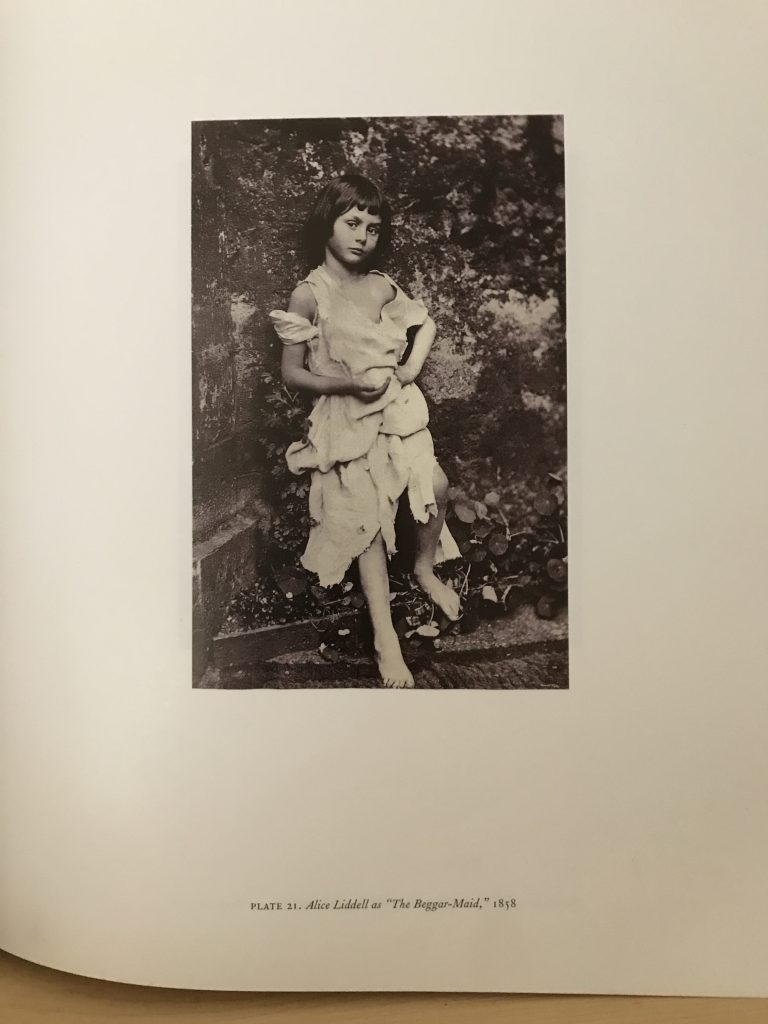
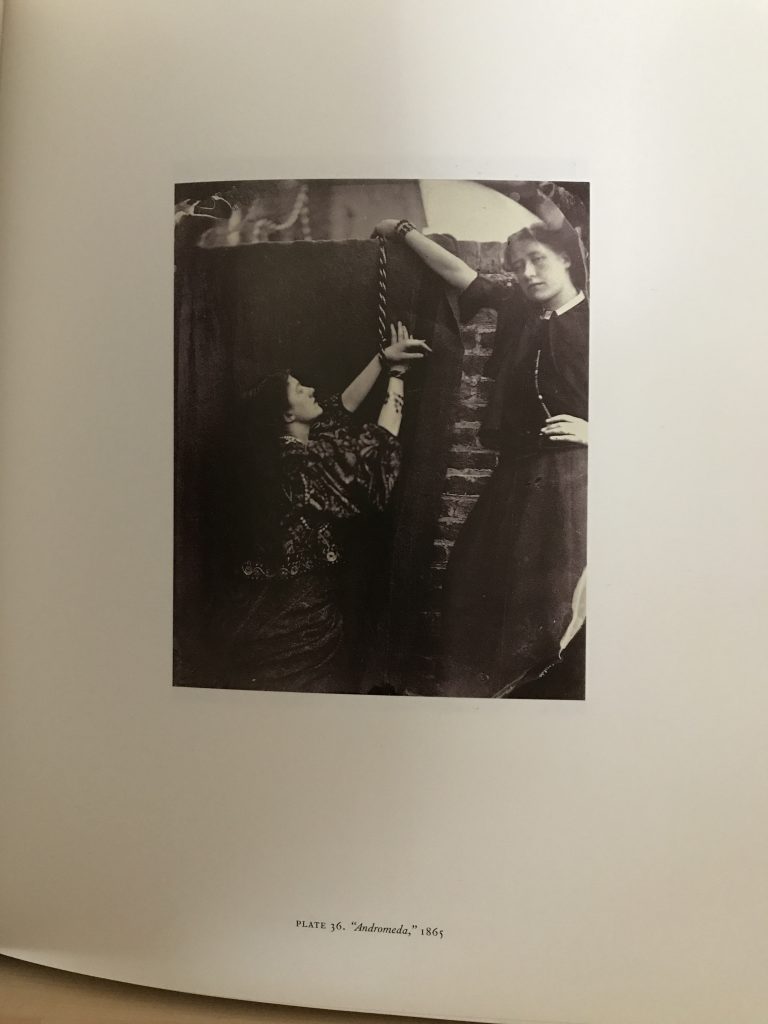
This week, having checked out the show’s catalog5 from my public library, I’m struck by how the cliché of the dirty old man (or author in this case) photographing young girls leaps out at the viewer. Except that the author was twenty-four years old when he began, and the chronicle of one of his photographic subject’s Adventures in Wonderland wasn’t published until nine years later. And pegging his photos as pedophilic can overlook the fact that, as Kimmelman writes, “new scholarship has uncovered evidence of a healthy adult, a clergyman with a mature sexual appetite who wrote grown-up love poetry and who was recalled fondly by the girls he photographed when they became adults.” Then why are years’ worth of Carroll’s diaries missing?
The catalog’s author Douglas R. Nickel explains that Carroll’s “rather normal male penchant for the company of winsome young (and not so young) women might have been tolerated by his relations [relatives] if his children’s books had not made Carroll an object of great public interest.”6 And so Carroll’s siblings entrusted and assisted a nephew, Stuart Dodgson Collingwood, to steer the famous author’s posthumous biography away “from any posthumous scandal.”7 Nickel writes that “Collingwood’s focused attention on his uncle’s fondness for little girls, while not untrue, was a deliberate diversion from an uncomfortable reality”—that Carroll had affairs with grown women whose marital status was no object—“such that the figure who emerges from his book is virtuous, devout, retiring, modest, asexual, charmingly eccentric, and completely unthreatening.” Well, the photographs threaten the 21st-century viewer—despite, as Nickel writes, that ‘[i]t was understood at the time that a girl was not a sexual creature until she had passed through puberty.”8
As I was preparing this post I received the November–December edition of the Gay & Lesbian Review (and yes, it’s the only periodical to which I subscribe…) in which Canadian writer Steven Spencer comments on the sexualization of male nudity during the second half of the 20th century. If at that time we became suspicious of Lewis Carroll’s photographic fixation, we’d also become hypersensitive about men and boys in the buff. Why? “Heterosexual men are paying an ironic price for gay liberation,” Spencer writes, pushing men away from each other in the face of the possibility that We Are Everywhere! “It is only the lingering aversion to homosexuality experienced by many straight men that leads to this insecurity.” Read “The Great Cover-Up” by Steven Spencer before it’s pulled from non-subscriber view.
The Lure of Stale Camp Glitter
I particularly wanted to take in a show of the French duo Pierre et Gilles, in Chelsea at the Robert Miller Gallery (closed in 2016). Miller, who died in 2011, championed women and gay artists. Patti Smith called him “my advocate and mentor.” I vaguely remember the Pierre et Gilles show’s images—a survey of their work from 1980 to the present—as being disappointing and highly sexual. (Or maybe there was a separate gallery space dedicated to such images?)
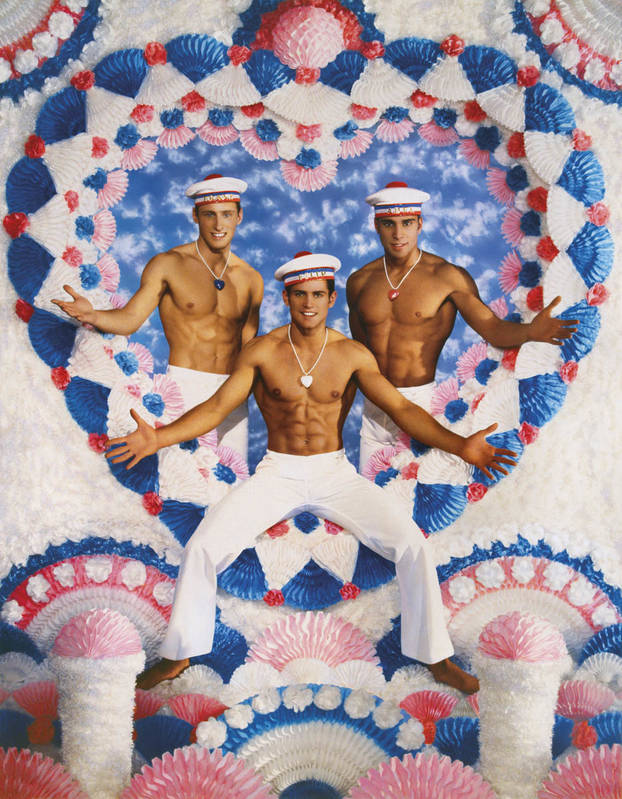
New York Times critic Grace Glueck, writing about the show, describes the image above, “Three plumply bare-chested sailors pose winningly against a Busby Berkeley-esque background of a giant lace-paper heart”—confusing the party-decoration tissue-paper fans and honeycomb balls for high-tea doilies. The image below: “a sultry seductress disports nude, save for a fetching wisp of bra, in field of flowers”—mistaking the sheer one-piece for a brassiere, i.e., not nude. If I was disappointed in the show, Glueck hated it. “Despite the ingenuity of the pair, and their much-touted impact on the art, news media and fashion scenes, the show, with its stale camp glitter, could top your can’t-wait-to-miss list.”9
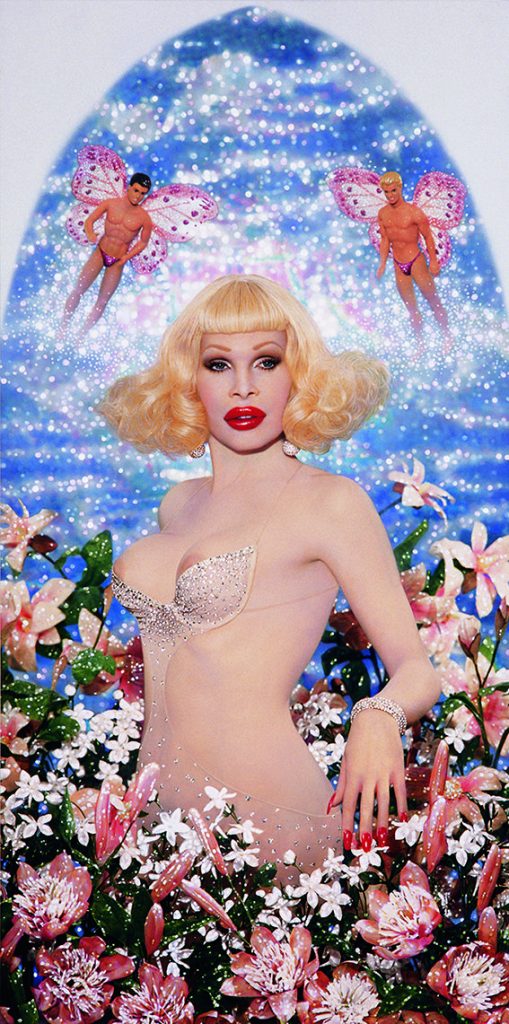
I don’t recall the particular contents of the Robert Miller show, but Glueck ignores the aspect of camp that Philip Core (one-time photography critic for The Independent) calls “the lie that tells the truth.”10 When viewing Pierre et Gilles’s portrayal of David et Jonathan (2005) as dark-skinned lovers (replete with keffiyeh headdress) on the one hand, and Adam and Eve (1981) with barely concealed tan lines on the other, I’m reminded of how Martin Scorsese dared to cast Harvey Keitel, a Jew, as Judas Iscariot (sans King’s English) in The Last Temptation of Christ: Biblical Brooklyn. Vive la Marine, above, toys with the dissonance between the grammatical gender of la Marine (the Navy) and that of le marin (the sailor), the latter being a recurring motif in the P&G oeuvre, and so the artists naturally cheer, Long Live the Navy! The Dream Girl Amanda Lapore is a self-identified transsexual attended in the P&G portrait by mature putti (prefiguring Barbie’s Lifeguard and Ken Fashionistas11) in a pointed-arch frame, a hallmark of Gothic architecture but with origins in India and southwest Asia—imagery of which are two other recurring P&G motifs. If Pierre et Gilles offend, they do so liberally. Hanging in Andrea’s and my bedroom is their Saint-François d’Assise (1988), which caused our friend (and reader!) Milania some consternation, Francis being dear to her heart.12 The image demands a reaction, as does doctors as clowns (n.d.; a commentary on treatment of people with AIDS?) and Le Printemps Arabe (Arab Spring, 2011; scroll to last slideshow on page).
The Painted Word
The last gallery we visited was at The Center for Book Arts, between Broadway and 6th Avenue on 27th Street. I had hoped to browse books for sale, but there was a class in session so we only were able to view the artist-member juried show. Book art runs the gamut from trade editions to one-of-a-kind, as demonstrated by these selections from that show.
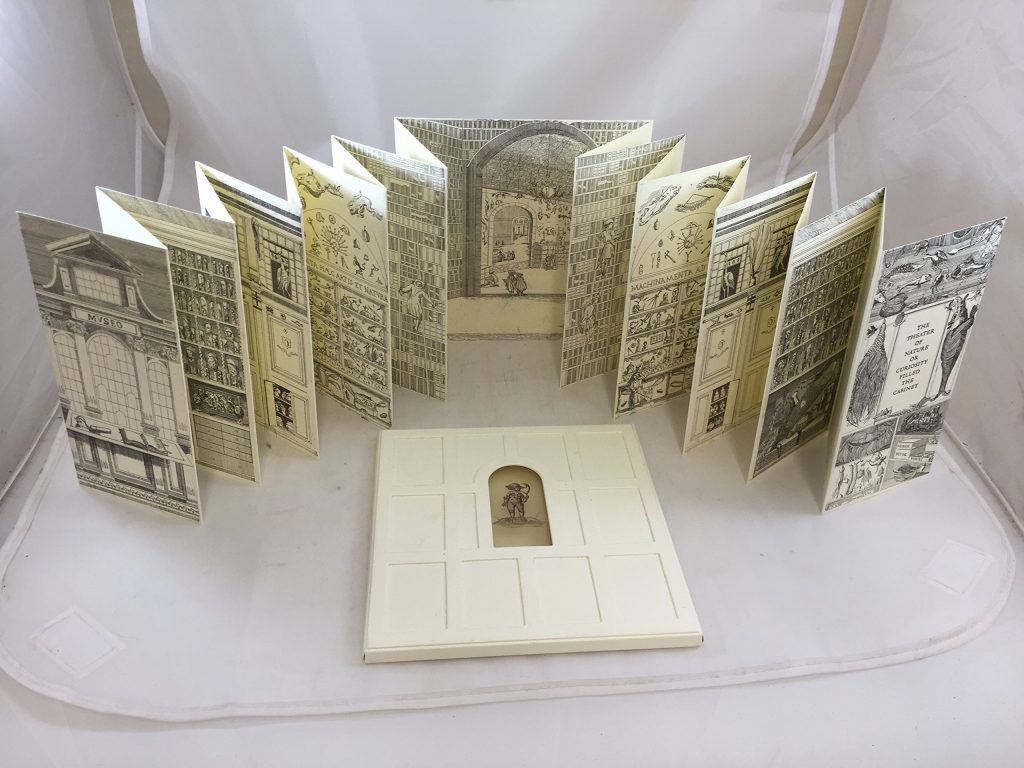

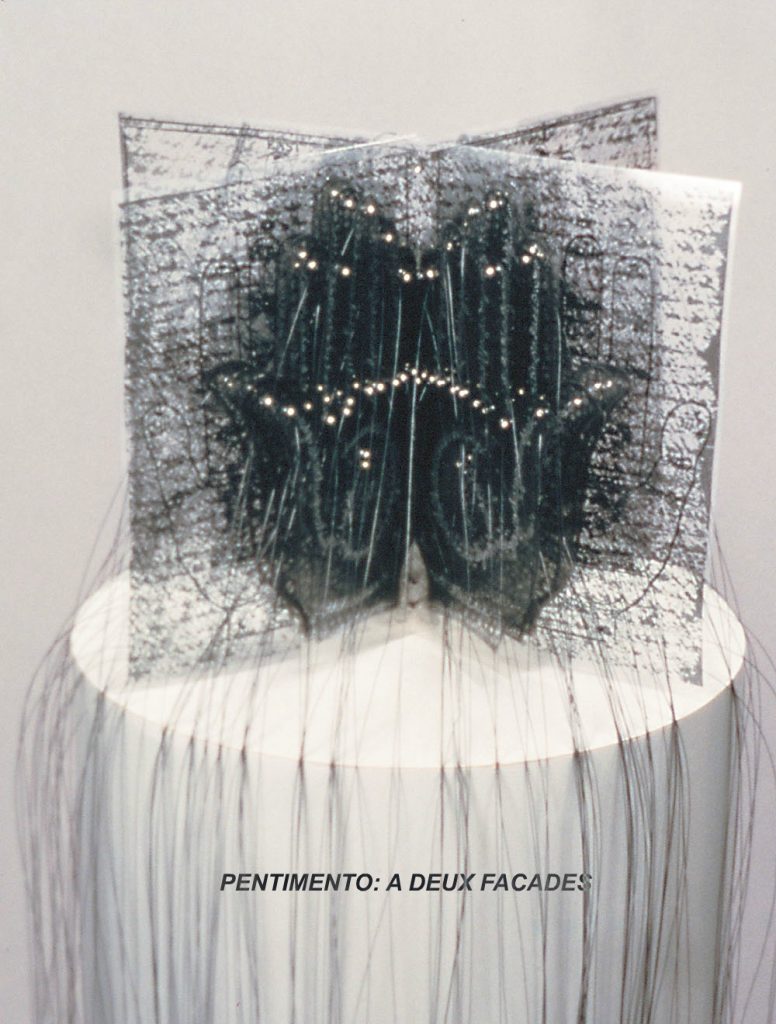
Felidia
Friday night we ate early at Felidia, the flagship restaurant of Lydia Bastianich, of public television fame, suggested by my co-worker, although Andrea and I never saw the TV show until we both were retired. Our server was an eastern European draft dodger with whom we chatted quite a bit (we were the only ones there at that hour). Andrea had a glass of 2001 Bruno Giacosa Dolcetto d’Alba. I had a Vespa Bianco—from the Bastianich estate of course—that was a nice blend of half-and-half Chardonnay and Sauvignon (both half-oaked) with 10% Picolit. We shared a red-and-yellow beet salad with green apples, dandelion sprouts, and blue cheese. Soup was asparagus with mozzarella. Andrea had lobster. (I guess the previous night’s extravagance carried over…) David had ricotta and nettle dumplings in a butter and cheese sauce. Dessert, oddly, was our first taste of panna cotta, this flavored with lemon verbena. Not having shared a bottle, David asked about Italian cordials and our server talked about how construction workers would come in for lunch and down several, then return to work. David had a portion of Brachetto, a sweet red.
PlayWright
We had plenty of time for an 8:00 curtain on the West Side. I’d consulted The Village Voice for theater options and settled on I Am My Own Wife by Doug Wright, based on a rave review by Michael Feingold. The play had been workshopped two years before in our then-neck of the woods, at the La Jolla Playhouse. We were seeing it off-Broadway at Playwrights Horizons a month after it had opened. Sitting a few rows in front of us was Harry Belafonte, who we’d seen on another stage the night before.
The story involves Wright’s probing of Charlotte von Mahisdorf, a transvestite Berliner who somehow had navigated through Nazi and Communist regimes, aided by her expertise in Wilhelmine decor. The one-person play is the result of interviews Wright conducted himself, interviews that eventually revealed inconsistencies in his subject’s story. Considering it now, the play foreshadowed my own investigations into early gay historical characters that I’d embark on three years later, setting the record, mm…, straight in a couple of instances. As Feingold notes, it “is a play which is in some ways not a play, and a piece of drama which is in all ways a piece of theater.”13 It’s an oral history-cum-docudrama, all thirty-five characters of which are played by its star, Jefferson Mays. Among other awards, the play went on to win a Pulitzer as well as Tonys for best play and best lead actor in a play. See a scene from a 2015 production in Sydney featuring Ben Gerrard (at 4:29).
“Ver o sol chegar” (“Watch the sun arrive”)
When we returned to L.A. I was so haunted by Bill T. Jones’s solo and its soundtrack that I emailed him to ask about it. Bjorn Amelan, Jones’s collaborator and then-partner/now-spouse, replied that it was performed to a song by José Afonso called “Menino do Bairro Negro.”
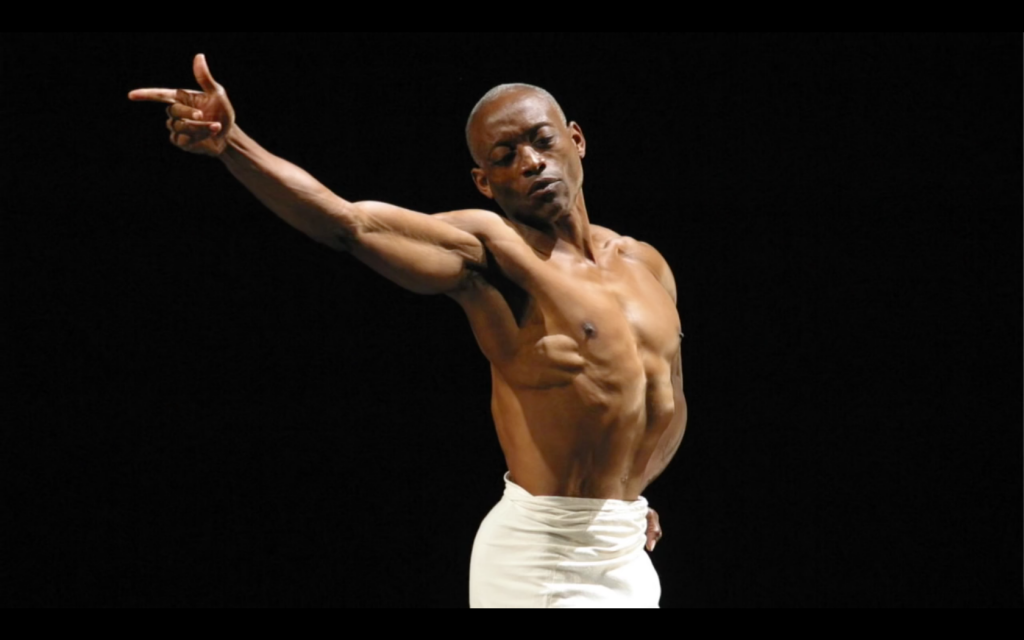
I found one streaming video of the song online and forgot about it. Now I see how it was a brilliant choice for the 2003 Celebrate the Children of Resistance performance. Given that, I’m saddened that no context for that choice was provided in the event program, but it might have been tough to tease out a meaningful one-line abstract.
José “Zeca” Afonso (1929–1987) was a Portuguese singer-songwriter who as a child experienced first-hand that country’s colonies of Angola and Mozambique, where his father was a judge.14 At nine years old, he moved in with an uncle, the mayor of Belmonte, Portugal, who insisted he join the Mocidade Portuguesa, an equivalent of the fascist youth organizations of Germany, Italy, and Spain. Two years later he moved in with an aunt in Coimbra. He began singing while a student at the University of Coimbra, founded in 1290, which he entered in 1949, studying history and philosophy. (The 1963 LP on which “Menino” first appeared is called Baladas de Coimbra, pictured below) He was a fellow-traveler of Communists but didn’t join the party himself. His songs are critical of colonization, imperialism, authoritarianism, and the Catholic Church, and supportive of labor, students, and revolution; for this he was fired from teaching, banned from performing, and briefly jailed. Having been so treated, he eschewed the laurels that came later in life; nonetheless he was reassigned to teach at the very school that had expelled him! Challenged by health his whole life, he succumbed to ALS (Lou Gehrig’s disease) in 1987, five years after diagnosis.
Zeca’s quotes, collected at the Associação José Afonso website, provide insight into his thinking. A taste:
Pamphletary art is not necessarily revolutionary. Many people are unaware that we do not have directly contentious art. Leafing through our romanceiros, our songbooks, there are no songs that call into question a given social-political structure. Not even the songs of derision and curse. Within our popular cultural heritage there is an implicit acceptance of existing structures. When you talk about folk art and you want a singer to translate an almost dialectically precise way of a social situation and propose a plan through your song, I think you are putting the cart before the horse. Before the songs there is a lot to do.15
I first assumed that “Menino do Bairro Negro” (Boy from the Black Neighborhood) called on Zeca’s memories of Africa, but my white perspective obfuscated the fact that most neighborhoods in Africa are black. An interview published in 2014 explains that the song is inspired by Afonso’s visits to Porto, Portugal’s second largest city.
It all shocked me in an amazing way. The first time I arrived in Porto after several car rides was at night… In one of the Ribeira neighborhoods16, I see four tipos [fig. fellows] urinating into a can. It was a highly surrealistic scene, but very treacherous. I remember seeing the boys who swarmed around those ilhas [lit. islands; fig. group of houses in a poor neighborhood]. It was something I thought only existed in the movies… It is Porto’s knowledge of all these realities that gave me the theme of “Boy from Bairro Negro.” I explained later that the blackness of which the song was speaking was not about skin color but about the condition of exploited boys diagnosed by Josué de Castro in his book Geopolitics of Hunger.17
And this, also from Zeca but otherwise unreferenced, in which he characterizes the song in philosophical terms:
Decent stylization of an indecent refrain collected in a wall full of Kabbalistic signs, of which, keep for posterity the most expressive jewels of the national lyric genres. […] The golden boys who inhabited the heavens before the Flood descend to earth and are condemned by the juvenile court to live in stilt dwellings until the Day of Final Judgment represented by a cardboard ball that descends, descends to touch the mountains.18
A translation of the song itself, connected with fado singer Mariza, is illuminating if not definitive. Again, it’s a song of solidarity with the boys of a neighborhood “the blackness of which […] exists in the stomachs diagnosed by Josué de Castro.”19
Even as the stanzas speak of the poorly dressed boy (“menino do mal trajar”), brother of the naked (“irmão de todos os nus”), their melody is playful, the refrain all the more plaintive by contrast:
Negro bairro negro
Bairro negro
Onde não há pão
Não há sossego
Black neighborhood
Where there is no bread
There is no peace
Yet at dawn that “cardboard ball” returns. And so the last verse is the same as the first.
Olha o sol que vai nascendo
Anda ver o mar
Os meninos vão correndo
Ver o sol chegar
Look at the sun that’s rising
Come to see the sea
The boys go running
Watch the sun arrive20
No Rest for the Wicked
Five years after our New York visit—on September 11 no less—New York Times urban affairs correspondent Sam Roberts reported that Morton Sobell, who had been convicted of conspiracy to commit espionage with the Rosenbergs, “admitted for the first time that he had been a Soviet spy.” Roberts is the author of The Brother: The Untold Story of Atomic Spy David Greenglass and How He Sent His Sister, Ethel Rosenberg, to the Electric Chair (New York: Random House, 2001).
Roberts didn’t simply cajole the 91-year-old Sobell to spill the beans over a beer in the Bronx. The occasion was the release that day by the National Archives—having been sued by a nonprofit, historians, and journalists—of most of the grand jury testimony in the case for which he’d been imprisoned. Roberts asked Sobell
whether, as an electrical engineer, he turned over military secrets to the Soviets during World War II when they were considered allies of the United States and were bearing the brunt of Nazi brutality. Was he, in fact, a spy?
“Yeah, yeah, yeah, call it that,” he replied. “I never thought of it as that in those terms.”
But Sobell hadn’t engaged in atomic espionage, instead having stolen “radar and artillery devices” for the Soviets, according to Roberts. “What I did was simply defensive, an aircraft gun,” Sobell said. “This was defensive. You cannot plead that what you did was only defensive stuff, but there’s a big difference between giving that and stuff that could be used to attack our country.” Roberts: “One device mentioned specifically by Mr. Sobell, however, the SCR 584 radar, is believed by military experts to have been used against American aircraft in Korea and Vietnam,” inferring that only the U.S. could be seen as acting in self-defense in those conflicts. Regarding his commitment to Communism and the Soviets, Sobell told Roberts, “Now, I know it was an illusion. I was taken in.”
As for Julius and Ethel, attorney David C. Vladeck, who had argued for release of the grand jury material, commented that those transcripts were at odds with the testimony at trial. “Imagine if the Rosenbergs had a good lawyer.”21
Header image:
Fernand Léger,
Mockup for a scarf, 1955
altered by David Hughes
Notes
- The Rosenberg Fund for Children, First Decade Report, 2000, 3.
- First Decade Report, 3.
- The Rosenbergs: Collected Visions of Artists and Writers, 2nd edition (Montague, Mass.: Cultural Forecast, 1988, 1993).
- “In an Unsullied Wonderland,” New York Times, 06 Jun 2003, E29, E31.
- Douglas R. Nickel, Dreaming in Pictures: The Photography of Lewis Carroll (San Francisco Museum of Modern Art and Yale University Press, 2002).
- Nickel, 26.
- Nickel, 24.
- Nickel, 26.
- “Pierre et Gilles,” 13 Jun 2003, E37. For an example of the artists’ impact, see “The Making of R.E.M.’s Iconic ‘Losing My Religion’ Video,” Rolling Stone, 11 Mar 2016; archived here. And the shirtless character who appears in the song’s 1991 promo video at 1:37 is remarkably similar to Charly, the model for P&G’s Le Garçon attaché (1993).
- Philip Core, Camp: The Lie That Tells the Truth (New York: Delilah Books, 1984).
- Lapore’s memoir is called Doll Parts, apparently in reference to her “obsessive dabblings in rhinoplasty, liquid silicone injections, eyelifts, and breast implants,” as noted in her online bio.
- The Pierre et Gilles Saint Francis in our bedroom is a postcard in a patina-ed traditional punched-tin frame I found on a visit to New Mexico. Hanging nearby this patron of animals and metalworkers (!) is John Lennon’s serigraph “I Do,” the acquisition of which Milania facilitated when she alerted me to remainders from a fundraising auction benefitting an HIV/AIDS nonprofit, for which I’m very grateful. The P&G rendition of Francis seems akin to a magazine photograph of actor (and Franciscan monk) Naziaro Gerardi on the set of The Flowers of St. Francis (Francesco, giullare di Dio), directed by Roberto Rossellini in 1950, as posted in Wikipedia.
- Michael Feingold, “Unnerving Berlin,” Village Voice, 03 Jun 2003; archived here.
- Biographical information obtained from Wikipedia and the Associação José Afonso.
- Excerpted from “Intervenção” on the eu dizia (I said) page of the Associação José Afonso website, translated mainly by Google.
- Ribeira is a UNESCO World Heritage Site, “an outstanding urban landscape with a 2,000-year history.”
- This quotation, translated by Google, is posted on the blog of a school library in Beiriz, Portugal, archived here. The quote is from José A. Salvador’s Zeca Afonso Livra-te do Medo, published in 2014. A brief overview of Josué de Castro’s thoughts about hunger is archived here. A sample: “It is clear that having a diversified and sufficient food supply will not solve the feeding need of the world population. Hunger is not just a matter of insufficient production of food. The population affected by hunger also has to have purchasing power to buy this food.”
- Excerpted from “Manino do Bairro Negro” on the verso dos versos (verse of verses) page of the Associação José Afonso website, translated by Google and Bing.
- This snippet is taken from the ellipsis in the block quote directly above.
- Translations are taken from Mariza, Google, and Bing.
- Sam Roberts, “Figure in Rosenberg Case Admits to Soviet Spying,” New York Times (online), 11 Sep 2008.

